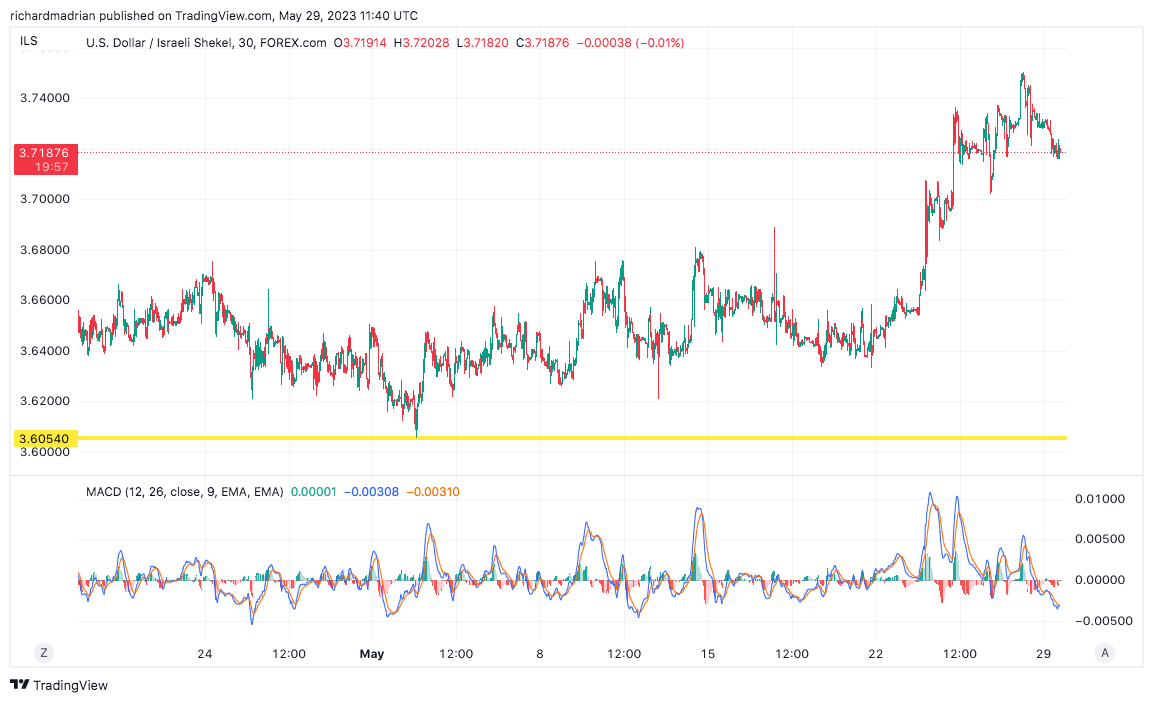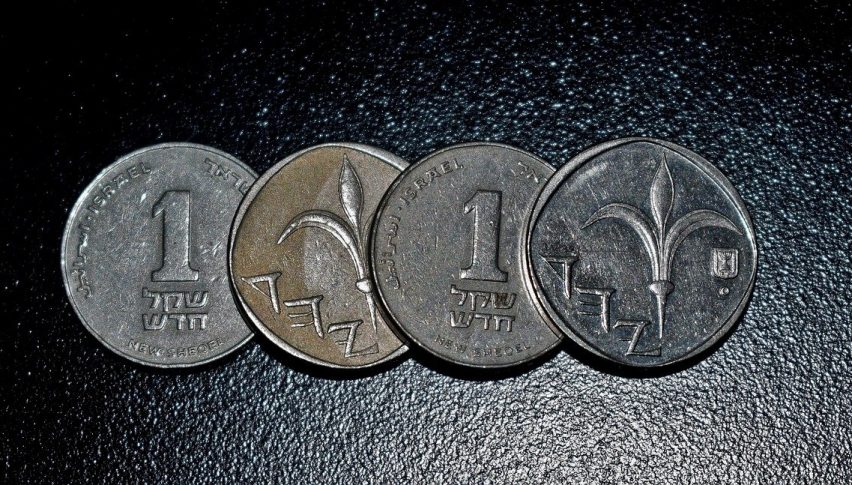USD/ILS Price Updates 2023 – 2024
The Israeli Shekel (ILS) started the 2023 financial year with a downtrend. The trend lasted for several weeks. Experts attributed the drop to various concerns around a potential economic fallout, Israel’s judicial system overhaul and the central bank raising key lending rates to curb inflation and save the weakening shekel.
Nonetheless, all technicals around USD/ILS are positive and indicate levels of bullishness. However, the big question is at what point will traders enter. The good news is that the USD/ILS pair already broke out by a whopping 17.5% around the start of March. Since then, the patterns, fundamentals and technicals have been showing more positivity. Take a look at the chart below and you will notice how the start of May has seen more buyers take over the market:

The USD/ILS traded in the 2.60s in the early 1990s. It was on a long-term bullish trend, which stretched further to the upside, as the pair nearly doubled in value by the early 2000s when it briefly broke above 5.00. The price didn’t stay there for too long, before reversing back down, and it has remained bearish since then.
USD/ILS Price Forecast: Historical background
From 2006 until the global financial crisis of 2008, this pair went through an accelerated decline, taking the price down to 3.20, before retracing higher for about one year, after the crisis. But, the decline resumed again in 2009 and it has been continuing in waves since then.
A support area, which lasted throughout the previous decade, formed around 3.40, but it was finally broken in late 2020. The GDP of Israel has been on a steady expansion in the last two decades, as global fundamentals have shown in our forex briefs, which has been one of the reasons for the downtrend in the USD/ILS. The coronavirus has messed up fundamentals everywhere now, but this pair is keeping up the bearish momentum, and it is now facing the previous low at 3.20.
Recent Changes in the USD/ILS Price
| Period | Change ($) | Change % |
| 6 Months | -0.22 | -6.4% |
| 1 Year | -0.27 | -7.8% |
| 3 Years | -0.29 | -8.3% |
| 5 Years | -0.64 | -16.4% |
| Since 200 | -0.94 | -22.7% |
Factors Affecting the USD/ILS
Right now, the coronavirus and the restrictions are a massive factor between recession and economic expansion in most countries, and they will continue to be so in the coming months at least. The economic factors that usually drive a currency, depend on it, which is also keeping the central banks dependent on how the situation will proceed. The technicals favour the Israeli Shekel, but if the situation changes, everything could flip over, although the central bank of Israel has increased the forex reserves, which is helping to keep the domestic currency well bid.
USD/ILS – Forecast Summary
| USD/ILS Forecast: H1 2023 Price: $3.80 – $3.90 Price drivers: USD sentiment, FED rhetoric, US politics, Covid-19 | USD/ILS Forecast: 1 Year Price: $4.0 – $4.3 Price drivers: Post COVID-19, Technical indicators, FED | USD/ILS Forecast: 3 Years Price: $4.0 – $4.5 Price drivers: FED monetary policy, Global politics, Global economy |
USD/ILS Live Chart
USD/ILS Price Prediction for the Next 5 Years
The US Dollar was on a bullish trend for several years, especially picking up pace from 2018 until March 2020. But the situation reversed since then, and the USD began faltering on a bearish trend at the height of the Covid-19 pandemic.
The US economy performed quite well since reopening in May 2021, and it kept pace in the fall as well, unlike in other places, where the economy was probably headed towards a recession. However, the US Dollar hit a constant decline, which accelerated in November 2021 after the US elections. Economists attributed this to the coming economic stimulus, which was around $ 2 trillion, and likely weakened the US dollar.
The economy of Israel, on the other hand, returned to contraction in the fall, when the new lockdowns were imposed, even though the restrictions have been eased somewhat since November. The economy bounced back nicely in Q3, as the GDP expanded by 37.9, in contrast to the 29.8% decline in Q2, during the first lockdown. Nonetheless, YoY GDP still remained negative in Q3, falling by 1.9%, following the 7.1% decline in Q2. Q4 should be worse, due to intensified restrictions, although the Israeli Shekel has been gaining ground against the USD, as the decline in the charts shows. But, that could also be attributed to the fall of the USD during 2020. The increase in forex reserves is another factor, although YoY CPI inflation has been negative since October 2020. But, the Bank of Israel (BOI) is probably the central bank that has cut interest rates the least in 2020, bringing them down to 1.60% from 1.75%, which is only a minimal cut. This has kept the Shekel steady, while the USD has been declining, pushing USD/ILS down.
USD/ILS Technical Analysis – $3.40 support holds, USD/ILS heading to $4.1
In this section, we will take a look at technical analysis for USD/ILS, which looks bearish, unless the previous low olds. In the early 1990s, this pair was trading at about 2.60, as we mentioned in the opening, but with a strong bias to the upside, which lasted throughout that decade. The pace of the uptrend was quite strong, and it accelerated further, pushing the price above 5 by the middle of 2002. But, that was it for buyers, and the reversal started to take place. We saw another attempt to the upside at the end of that year, but buyers failed to reach the 5 level, and the price formed an upside-down pin candlestick in February 2003, which is a bearish reversing signal after the uptrend.

Since then, the pressure has been to the downside, despite the bounce off the low at 3.20, after the 2008 crisis. That is confirmed by the lower highs in the USD/ILS pair, which have been declining during every retrace higher. Moving averages have been doing a great job as resistance, particularly the 200 SMA (purple) on the monthly chart, which stopped the climbs throughout the last decade, while the bottom was provided in the area around the 3.40 level. In February this year, the price bounced off that support zone for the last time, and the price surged to 3.89 during the panic in March, but the 200 SMA put a stop to the surge and the price finally broke the support zone in the second half of 2020. Now the USD/ILS is heading lower, and if the 2008 low of 3.20 is broken, this pair will head for 3.00.

